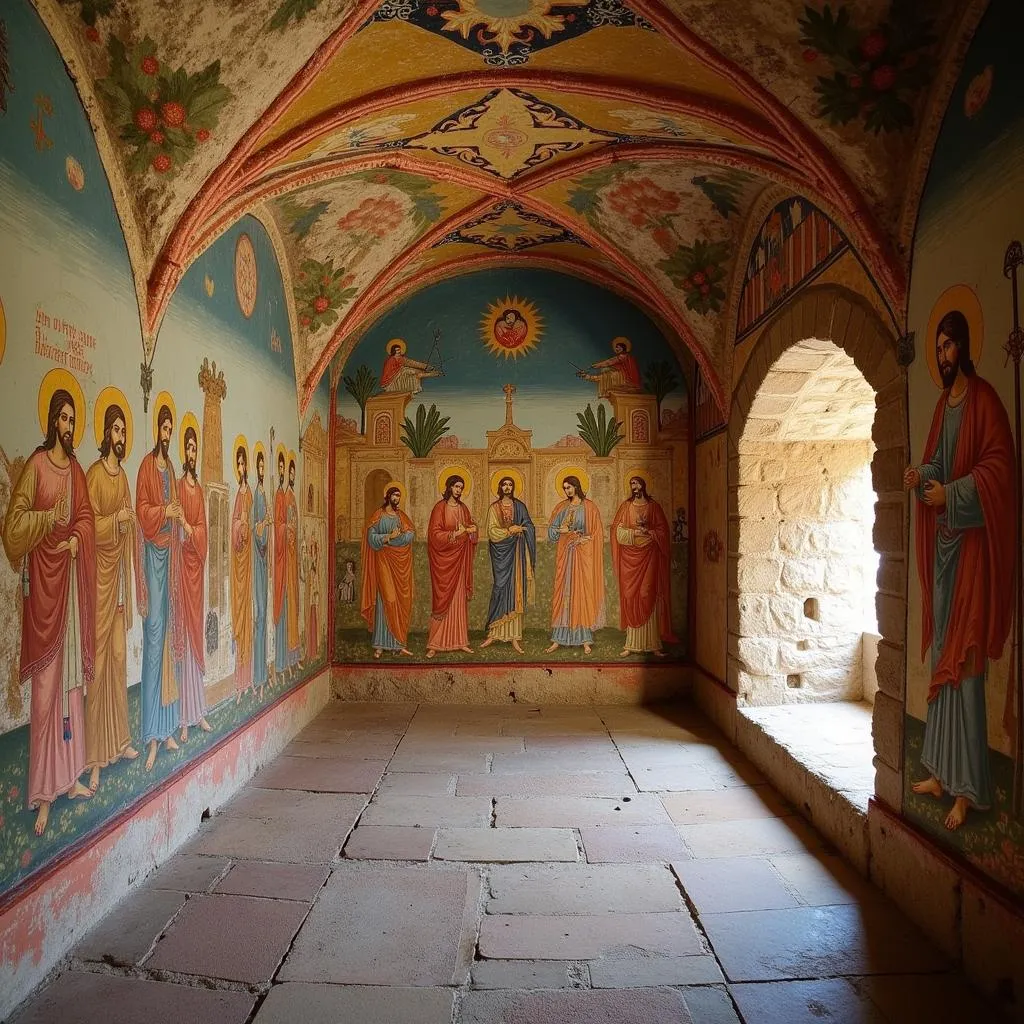Big Modern Art Paintings: A Celebration of Scale and Innovation
The world of “Big Modern Art Paintings” is one where size meets concept, where vast canvases become arenas for artistic exploration and expression. These monumental works, often exceeding traditional easel paintings by several folds, command attention and challenge our perception of art’s boundaries. From the bold strokes of Abstract Expressionism to the immersive installations of contemporary art, large-scale paintings have consistently pushed the envelope of creativity throughout the 20th and 21st centuries.
The Impact of Scale: Why Size Matters in Modern Art
One cannot discuss big modern art paintings without addressing the inherent power of scale. Large-scale artworks possess an immediate, visceral impact that transcends mere aesthetics. They envelop the viewer, creating an immersive experience that draws us into the artist’s world.
Think of Jackson Pollock’s expansive drip paintings, where the viewer is practically dwarfed by the artist’s energetic movements immortalized in paint. Or consider Mark Rothko’s iconic color fields, where immense canvases saturated with vibrant hues evoke a sense of the sublime and invite contemplation. In both cases, size is not just an aesthetic choice; it’s integral to the artwork’s impact, influencing how we experience and interpret it.
Beyond Aesthetics: Exploring the Conceptual Significance of Size
Beyond their visual impact, big modern art paintings often carry profound conceptual weight. The decision to work on a grand scale can be a deliberate artistic statement, reflecting the artist’s ambition, social commentary, or desire to challenge artistic conventions.
For instance, the imposing scale of many Minimalist works, often characterized by their repetition and industrial materials, aimed to confront viewers with the sheer physicality of the art object, stripping away traditional notions of beauty and representation. In contrast, some contemporary artists use large canvases to address socio-political themes. Their works might depict sprawling urban landscapes, reflecting on themes of globalization and urbanization, or engage with historical narratives on a grand scale.
Materials and Techniques: Navigating the Challenges of Large-Scale Art
Creating big modern art paintings presents unique technical challenges. Artists working on a large scale must carefully consider their choice of materials and techniques. The traditional easel and brush might be replaced with industrial scaffolding, spray guns, or even unconventional tools like rollers and sponges. The sheer volume of paint required can be significant, and the drying time of different mediums becomes a crucial factor in the creative process.
These practical considerations often influence the final aesthetic of the artwork. For example, the use of acrylic paints, known for their quick drying time, became popular among Abstract Expressionists like Helen Frankenthaler, who pioneered the “soak stain” technique, allowing diluted paint to seep directly into the canvas, creating luminous washes of color.
Experiencing Big Modern Art Paintings: A Feast for the Senses
There’s a distinct difference between viewing a reproduction of a large-scale artwork and standing before the real thing. The sheer scale can be awe-inspiring, pulling you into a dialogue with the piece. The texture of the paint, the artist’s brushstrokes, and the subtle variations in color become all the more apparent. This immersive experience is something that simply can’t be replicated in a smaller format.
Museums and galleries play a crucial role in making these experiences accessible. Institutions like the Museum of Modern Art (MoMA) in New York City or the Tate Modern in London dedicate significant exhibition space to large-scale installations, allowing visitors to fully appreciate their impact.
Conclusion: A Testament to Artistic Vision and Innovation
Big modern art paintings are a testament to artistic vision and innovation. They challenge our perceptions, provoke dialogue, and offer a unique lens through which to view the world. Whether exploring the depths of human emotion or reflecting on social and political realities, these monumental works continue to inspire and captivate audiences worldwide. So next time you have the opportunity to experience a large-scale artwork in person, take a moment to appreciate the sheer audacity of its creation and the powerful dialogue it sparks between art and viewer.
FAQs:
-
What defines a painting as “large-scale”?
There’s no strict definition, but generally, artworks exceeding 6-8 feet in any dimension are considered large-scale. However, context matters! -
Where can I see big modern art paintings?
Major museums like MoMA, Tate Modern, and the Centre Pompidou are great places to start. Check for special exhibitions too! -
Who are some famous artists known for large-scale paintings?
Jackson Pollock, Mark Rothko, Clyfford Still, Helen Frankenthaler, and Anselm Kiefer are just a few. -
Are large-scale paintings only found in museums?
Not necessarily! While museums house significant collections, some private collectors and galleries also showcase these works. -
What’s the impact of large-scale art on the viewer?
It can be profound, evoking awe, contemplation, and a deeper engagement with the artwork’s message and techniques.
For those interested in exploring different art styles, we recommend checking out our film noir art collection. And for art lovers looking for unique pieces, our Hawaii art prints might pique your interest.
If you’re seeking to add a touch of the Southwest to your home, we offer a stunning selection of large southwestern wall art. And for those with a penchant for religious art, our art prints Christian collection is sure to inspire. Finally, if you’re ever in Springfield, TN, don’t miss the vibrant art in the park springfield tn exhibitions.
For any questions or assistance, please contact us at:
Phone: 02462573573
Email: danteum@gmail.com
Address: Savico Megamall, 7-9 Đ. Nguyễn Văn Linh, Gia Thụy, Long Biên, Hà Nội 10000, Việt Nam.
Our customer support team is available 24/7.

